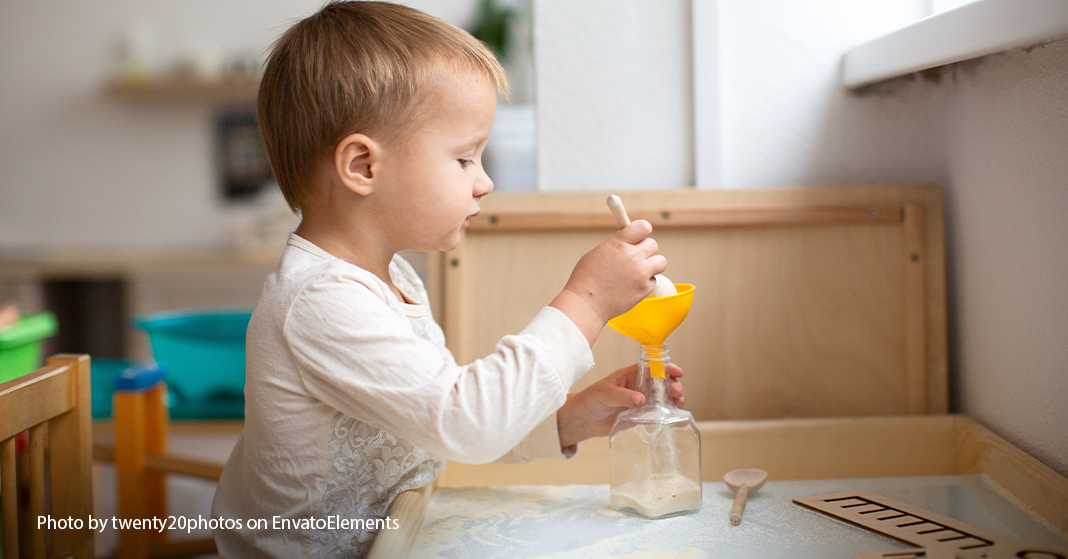
Small children want your attention, especially when you’re busy. You know the feeling. An easy way to appease them is to hand them your phone. I was guilty of this recently when my daughter was getting restless and noisy as we sat in a meeting. Sometimes playing a game or watching a show on your phone is a good solution. But during school time, you would like for your young children to be learning and developing too. Sensory play is the perfect way to help small children learn and develop motor skills while you are busy teaching your school-age children.
What Is Sensory Play?
Sensory play is any activity in which children use one or more of the seven senses. You probably learned your five senses—taste, touch, smell, sight, and hearing—as a child. Experts have also added movement and balance to this list. Children learn about the world primarily through their senses. They develop gross and fine motor skills with movement and balance. They learn to balance not only their own bodies, but also other objects. Children develop coordination by reaching hands across the body.
Reusing Food Containers
Many different materials are useful for sensory play. Food containers are quite versatile. Save plastic containers or cardboard boxes from the grocery store. Small children can hit them to make noise or stack them to practice motor skills and balance. Different shapes and sizes of tubs or boxes work well for stacking games. If you put beans, rice, or pasta inside, the containers will make great shaking toys. Use containers with varying opening sizes for small children to practice transferring items like pompoms or small toys. For increased difficulty, give your child tongs or measuring cups.
Sensory Bin Activities
Get some large plastic bins and create a safe place to make a mess. Lay a large towel or blanket down with a sensory bin on top.
- You may want to give each bin a theme. One day, your bin could contain straight objects, like crayons, paintbrushes, or uncooked spaghetti. Any child-safe objects you have around the house will work. Varying the textures will engage their sense of touch.
- Fill a bin with objects you find outside. Toddlers love rocks, leaves, and pine cones.
- Put small toys in the bin, and have your child sort them by color or size.
- Make some flavored gelatin with clean, small toy animals trapped inside. Allow little ones to free the animals while tasting the gelatin. Encourage them to make the animal’s sound as they free it.
- Give children some oranges cut in half. Encourage them to squeeze the juice out and taste the oranges, or even to try to stack them.
- Fill a sensory bin with different shapes of uncooked pasta and allow children to sort them.
Other Sensory Play Activities
- Add essential oils to homemade dough to engage the sense of smell. Make impressions in the dough with small toys.
- Have your toddler push small toys into a reusable baby wipe container. You may have to open it for her over and over.
- Cut a slot into a box or other container, and give your toddler some cards to put into the slot. Make sure the slot is the right size to offer a little challenge to his motor skills.
- Partially fill water balloons with flour, rice, or beans, and let your children explore the different textures.
- Glue ribbons with different textures onto a plastic lid for younger ones to touch.
- Give them picture books with textures or flaps included.
- Explore temperatures with ice and warm water.
- Allow your child to paint with water. This is a great activity for outside. For an indoor alternative, put her in a highchair to paint a piece of construction paper.
- If you have musical instruments, your children can experiment with loud and quiet or different rhythms.
Activities that Encourage Movement
- Make an obstacle course.
- Use tape to create a curvy line on the floor for kids to follow, either crawling or walking. Encourage children to follow the line with a toy car using only one hand.
- Play some marching music and have children march and touch each knee with the opposite hand.
- If you have a ball, the right size for your child to sit on, have him try to balance while swaying on the ball.
- Crab walking or pretending to skate across a hard floor in your socks are fun ways to race. See if you can think of other unique ways to traverse a room quickly or slowly.
- Having children jump on a bed or couch is great for balance if you and your furniture can tolerate it.
Plan Ahead
Some of these activities require a bit of preparation, while others are quick to put together. With any of these activities, be sensitive to your child’s safety. You may need to modify activities if your children still put most items in the mouth. Sensory play can occupy small children for a relatively long time. They learn and develop skills while playing. Put your sensory bins or activities where you can watch your little ones entertain themselves. Then you can teach your older children, knowing that the younger children are learning too.
• • • • •
Valerie is a wife and a mother to a very busy toddler. In her free time she enjoys reading all kinds of books. She earned a B.S. in Biology from Bob Jones University, minoring in Mathematics, and a Ph.D. in Molecular Genetics from Ohio State University. Valerie has 15 years of experience working in research laboratories and has coauthored 8 original research articles. She has also taught several classes and laboratories at the high school and college levels. She currently works as a Data Analyst and a freelance writer.
Leave a Reply